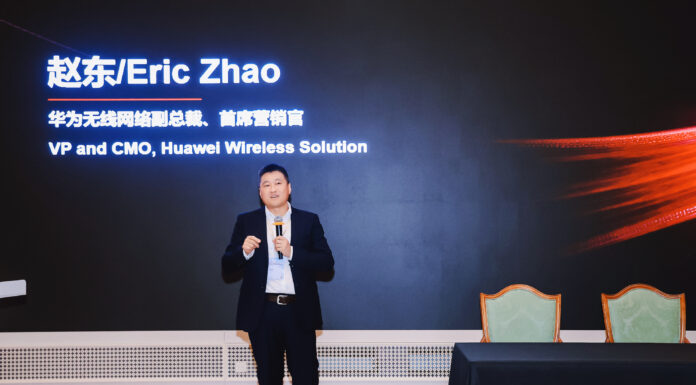The global mobile communications industry is entering a new phase defined by rapid 5G-A deployment and the deep integration of artificial intelligence, with operators beginning to see commercial value and new business models taking shape, Eric Zhao, Vice President and Chief Marketing Officer of Huawei Wireless Network Product Line, said in an interview with RCR Wireless News.
According to Zhao, the past year has been transformative. “The first change I’d like to discuss is that 5G-A networks and devices have matured,” he said, adding that the number of commercial 5G-A networks worldwide is set to reach 50 this year, covering over 300 cities. Device support already encompasses over 100 models. China’s three major carriers have actively launched various types of 5G-A plans to meet the personalized needs of different user groups, the executive said. Globally, operators are marketing 5G-A with tailored packages: Kuwait’s Zain, stc, and Ooredoo have introduced layered 5G-A plans priced around 50% higher than 5G, while operators in Thailand and Singapore are offering plans with speed boosts and scenario-specific guarantees. “These offerings have helped operators increase the average revenue per user of 5G-A,” Zhao noted.
He said another key shift is the accelerating integration of 5G-A and AI. “Today, operators are exploring the commercial application of 5G-A and AI,” Zhao explained. In China, China Mobile Guangdong has partnered with device makers to release AI-powered phones with 5G-A capabilities, faster connections, and embedded features like AI agents, AI calling, and quantum-encrypted messaging. Deutsche Telekom in Germany has unveiled a new AI device that, Zhao said, “exceeds the overall AI performance of iPhones,” while LG U+ in South Korea is deploying AI to help SMEs improve efficiency. The convergence of these technologies has also been featured at global events such as the World Artificial Intelligence Conference, which hosted a dedicated “Radio and AI” forum for the first time, and the World Humanoid Robot Games, where China Unicom provided 5G-A connectivity to support event operations. “Overall, the global mobile communications industry is demonstrating strong innovation potential,” Zhao said, adding that the momentum is “being driven by rapid 5G-A commercial deployment and AI’s deep integration with mobile communications.”
Looking forward, Zhao argued that the mobile AI era will be centered on agents. “The upcoming mobile AI era will center on agents. And AI agents will be used in all aspects of our lives,” he said. To capture this opportunity, Huawei sees two immediate priorities: building stronger collaboration with operators, industry groups, and partners, and developing new business models. “We must establish more efficient communication mechanisms to drive consensus and align standards,” Zhao stressed, pointing to the company’s joint “5G-AxAI Campaign” with GSMA and GTI. As part of this initiative, Huawei’s “Intelligent RAN, Ubiquitous AI Project” has already built autonomous network benchmarks in 12 cities worldwide.
The second priority is experimenting with fresh value models. “5G-A and mobile AI will create value that extends far beyond just traffic growth,” Zhao said. This requires moving “from selling connections to selling capabilities, and from charging for pipes to sharing value.” He highlighted China Mobile’s partnership with Shanghai Shenhua Football Club, which offers fans enhanced 5G-A mobile plans that guarantee faster speeds and boost loyalty. “I believe that next year, more popular business models will emerge to accelerate shared success,” Zhao added.
Huawei’s latest step in this direction is the announcement of the innovative direction for future network evolution: AgenticRAN , a new architecture designed to apply AI across wireless networks. “The mobile industry is seeking new innovations, while AI is rapidly advancing. How can we apply AI to mobile networks? We can begin with wireless scenarios,” Zhao explained. He identified three critical factors for evaluating AI adoption: effectiveness, reliability, and cost. Effectiveness requires generalization across scenarios; reliability depends on stable operations without unpredictable faults or “hallucinations”; and cost must reflect efficiency-first principles.
With these factors in mind, AgenticRAN introduces AI in a layered and reasonable manner. The business layer, Agentic Service, uses AI to help operators open network capabilities flexibly and monetize more efficiently. At the O&M layer, Agentic AN enables multi-objective optimization and integrates with operators’ management systems to achieve higher levels of autonomy. Huawei adopts an adaptive approach to introducing AI and algorithms into wireless networks, continuously improving the spectral efficiency and energy efficiency of wireless communications, and flexibly utilizing time, frequency, space, and power resources to achieve the optimal balance between performance and efficiency.
“We are confident that AgenticRAN will set new records in spectrum efficiency, energy efficiency, and network automation, pushing the entire industry forward,” Zhao said.
For Huawei, these efforts reflect a broader strategy of enabling ecosystem growth. “We are committed to achieving shared success with industry stakeholders through continual technological evolution, ecosystem building, and application deployment,” Zhao emphasized. With 5G-A rollouts gaining speed, AI agents emerging, and architectures like AgenticRAN offering layered innovation, Huawei believes the industry is poised for a new wave of opportunity. “With AI, we believe that the mobile industry has unlimited potential,” Zhao concluded.

